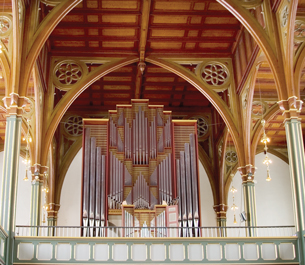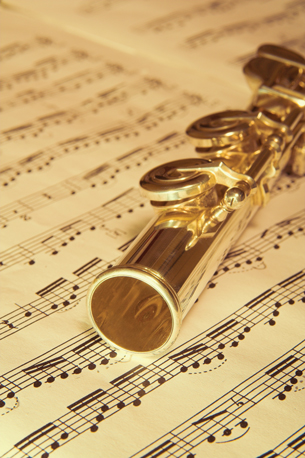Module 8—Mechanical Waves
 Reflect and Connect
Reflect and Connect

© Tyler Olson/shutterstock
Air column resonance, whether open or closed, is heard as an amplification of the tone that enters the air column. The amplification is based on constructive interference that occurs at the opening (or openings) of the air column. Each organ pipe is cut to a specific length so that the standing wave inside of it will exhibit constructive interference at the openings. In order to predict the length of pipe that will resonate, an organ designer has to know the speed of sound and the frequency of the sound that will be resonating in the open air column.
Applying the universal wave equation, the designer can determine the wavelength and then cut the pipe at the proper one-half wavelength interval. By making the pipe length an interval of one-half the wavelength, the designer is able to construct an organ that is suitably loud, without any need for electrical amplification. This fact, among many others, is why organs were extensively used in churches that were designed long before electrical amplifiers.
Add varying amounts of water to the empty bottle that you had at the beginning of this lesson, and observe the change in pitch (frequency) of the note produced when you blow across the bottle. Obtain a second bottle with a narrow neck, and, with another student if possible, use water levels to “tune” both bottles to the same frequency. You may be able to produce a sound regardless of the amount of water in the bottle, so listen carefully for that clear, loud tone and adjust the water as needed.
 Module 8: Lesson 4 Assignment
Module 8: Lesson 4 Assignment
Remember to submit the answer to Discuss to your teacher as part of your Module 8: Lesson 4 Assignment.
 Discuss
Discuss

© Darko Novakovic/shutterstock
A wind instrument, such as a flute or clarinet, is designed in such a way that the length of the air column can effectively be changed by opening and closing holes in the instrument. The resonant frequency that will be heard from such instruments is produced by a wave that is twice as long as the distance between the mouthpiece and the first open hole in the instrument. This wave is known as the fundamental frequency. However, an instrument will produce its own unique sound even if it has the same fundamental frequency as another type of instrument. For example, a flute and a clarinet could have the same air column length, producing the same fundamental frequency, but they don’t sound the same. Why? They have different timbre or tone colour, the quality that allows you to distinguish different instruments even if they play the same note.
In the discussion forum, explain why these instruments must be an open air column. Using page 423 of your textbook as a source, explain how overtones give each wind instrument a unique sound even though they may resonate with the same fundamental frequency.
 Reflect on the Big Picture
Reflect on the Big Picture
Each of the Reflect on the Big Picture sections in this module deal with waves and transferring energy. To reinforce your learning from this lesson, complete at least one of the following reflection activities:
- Do a quick survey of three or four friends who are not taking physics. Find out from them what they think determines the pitch of a flute or clarinet. When you have your friends’ opinions, summarize their ideas into two categories: misconceptions and facts. Explain why items are in each column.
- Have you heard a live performance on a pipe organ or a recording with a pipe organ on it? Does the volume of sound coming from simple pipes and moving air surprise you? Create a drawing or a multimedia presentation that helps explain how something so simple can be so loud.
Store your completed reflection in your Physics 20 course folder.
 Module 8: Lesson 4 Assignment
Module 8: Lesson 4 Assignment
Remember to submit the Module 8: Lesson 4 Assignment to your teacher.